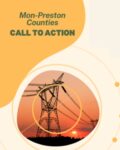By Don Garvin
If you ever wondered why we need a West Virginia Environmental Council, just consider the following: An October 17, 2007 Forbes magazine article ranks West Virginia as No. 50 – dead last – in the magazine’s first-ever list of America’s “Greenest” States.
“So who’s at the bottom?” the magazine asks. According to the magazine, “ Mississippi, Louisiana, Alabama, Indiana and, at No. 50, West Virginia. All suffer from a mix of toxic waste, lots of pollution and consumption and no clear plans to do anything about it. Expect them to remain that way.”
The article contains a photograph of a mud-swollen West Virginia stream, accompanied by the following text:
“West Virginia — No. 50
Score: 14.2 out of 50
West Virginia posted low scores in every category, notably carbon footprint (fourth highest) and water cleanliness (we ranked it fourth worst). It’s got more toxic waste to manage per capita than all but three states. In 2005, it disposed of or released 97.1 million lbs of toxic waste. The state exceeded its Clean Water Act permit levels by an average of 679% in 2005, according to U.S. PIRG. This means the water was frequently grossly tainted.”
Here’s the full text of the article as posted on Forbes.com.
The Environment: America’s Greenest States
Brian Wingfield and Miriam Marcus 10.17.07, 6:00 AM ET
Washington, D.C. – When you think “green,” you think New Jersey, right? OK, maybe not. But perhaps you should.
The Garden State ranked seventh in our first-ever list of America’s Greenest States, a surprise winner amid places synonymous with environmentalism like Vermont, Oregon and Washington.
More startling: The congested East Coast is a lot more environmentally friendly than you thought.
Sure the Western U.S., with its big skies and open spaces feels green–but when you look at broader measurements of humans’ impact on the environment, including consumption patterns, air and water quality, and waste, as well as policy, they don’t fare as well.
Despite the acreage and lack of people, as well as mountains of regulation in California, Westerners drive further and use more resources than their cramped Eastern cousins. Still, Idaho, Colorado, New Mexico and Nevada all finished in the top 20.
On top: Vermont, Oregon and Washington. All have low carbon dioxide emissions per capita (or “carbon footprints”), strong policies to promote energy efficiency and high air quality, as indicated by their major metro areas that are low in smog and ozone pollution. They’re also among the states with the most buildings (on a per capita basis) that have received the U.S. Green Building Council’s benchmark certification, known as Leadership in Energy and Environmental Design (LEED).
A clutch of Eastern states round out the top 10. New Jersey makes the cut not because it excels in one particular area–though it has implemented strong policies to promote energy efficiency–but because it gets relatively high marks in just about every category. In only five states did people travel fewer miles in their vehicles than they did in New Jersey in 2005, the most recent year for which government data is available. That same year, 42 states exceeded their Clean Water Act permit limits by levels greater than New Jersey did, according to the watchdog group U.S. PIRG. And 33 states managed more toxic waste per capita than New Jersey. In other words, don’t let the poor air quality in Newark fool you.
Another example: Maryland. Only 10 states have a lower carbon footprint per capita than Maryland, and the state has a relatively low instance of water facilities exceeding their Clean Water Act permits, according to PIRG. In addition, Maryland ranks 40th in total energy consumption nationwide, and it managed less toxic waste per capita than all but six states in 2005. And earlier this year it joined a group of Northeast and Mid-Atlantic states to cap greenhouse gas emissions and trade emissions credits.
Then there’s tiny Rhode Island. The state has mandated that utilities obtain 16% of their power from renewable fuel sources by 2020. It has the lowest energy consumption per capita of any state in the country, and only two states have lower carbon footprints than Rhode Island, government data show.
One of the most startling findings on our list is that California doesn’t crack the top 10, despite routinely setting the bar for environmental policy. At least five of its metropolitan areas, including Los Angeles, Bakersfield and Fresno, appear on the American Lung Association’s 2007 list of cities with the worst long-term smog and ozone pollution. And 69% of its major water facilities exceeded their Clean Water Act permit limits at least once in 2005, according to PIRG. That’s the 10th worst percentage in the country.
Likewise, there’s no Rocky Mountain high in the top 10. Colorado, famous for outdoor recreation, does have great air quality, but its carbon footprint per capita is only the 24th best in the nation. It doesn’t have particularly poor water quality or energy efficiency policies or an abnormally high amount of toxic waste, but the state’s rankings in these categories aren’t outstanding either. It clocks in at No. 13 on our survey.
A bit about our methodology–we ranked each state in six equally weighted categories: carbon footprint, air quality, water quality, hazardous waste management, policy initiatives and energy consumption.
Because carbon dioxide is the most prevalent greenhouse gas, carbon footprint provides a fairly good example of overall emissions levels. For air quality, we have relied on the American Lung Association’s 2007 State of the Air Report to determine which metro areas have the best and worst pollution. Because EPA’s most recent comprehensive data on water quality is five years old, we have relied on PIRG’s water assessment released in October 2007 to complete our analysis in that area. Each state’s hazardous waste management per capita has been determined using the most recent information available (2005) from EPA.
For our rankings on policy initiatives, we use the American Council for an Energy-Efficient Economy’s energy efficiency scorecard, released in June 2007. Regarding energy consumption and lifestyle choice, we examined a number of factors, including vehicle miles traveled and the number of alternative fuel and hybrid-electric vehicles per capita by state, as well as the number of buildings that have received the U.S. Green Building Council’s energy efficient “LEED” certification. We have also relied on information from the Energy Information Administration, the Environmental Protection Agency, Department of Transportation, the Natural Resources Defense Council and the Sierra Club. All data are the most recent available.
So who’s at the bottom? Mississippi, Louisiana, Alabama, Indiana and, at No. 50, West Virginia. All suffer from a mix of toxic waste, lots of pollution and consumption and no clear plans to do anything about it. Expect them to remain that way.









